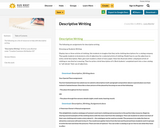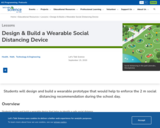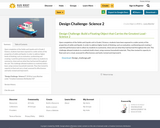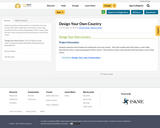
The following are a list of resources to help with descriptive writing.
- Subject:
- English Language Arts
- Material Type:
- Homework/Assignment
- Lesson
- Date Added:
- 10/05/2018

The following are a list of resources to help with descriptive writing.

Students write descriptions of 100th day bottles they create at home, write clues about their bottles for a guessing game, practice descriptive writing, and create a class book.

Use the slippery sidewalks as inspiration to try this practical activity! Students work collaboratively to design and build a non-slip boot tread that uses friction to prevent slipping on an incline.
All materials are listed and provided including assessment and supporting media.

Explore this fun, new lesson with your classroom as students design and build a wearable social distancing device!

Students design and build model landfills using materials similar to those used by engineers for full-scale landfills. Their completed small-size landfills are "rained" on and subjected to other erosion processes. The goal is to create landfills that hold the most garbage, minimize the cost to build and keep trash and contaminated water inside the landfill to prevent it from causing environmental damage. Teams create designs within given budgets, test the landfills' performance, and graph and compare designs for capacity, cost and performance.

Upon completion of the Solids and Liquids unit in Grade 2 Science, students have been exposed to a wide variety of the properties of solids and liquids. In order to address higher levels of thinking, such as evaluation, synthesizing and creating, I used this performance task to allow my students to summarize, show and use what they had learned throughout the unit. This challenge allowed students to creatively build a boat, using common household materials. They then tested its capacity to float and carry a load, assessed its effectiveness and lastly revised and improved it.

Students discover how engineers can use biomimicry to enhance their designs. They learn how careful observation of nature becoming a nature detective, so to speak can lead to new innovations and products. In this activity, students reverse engineer a flower to glean design ideas for new products.

Students use their creative skills to determine a way to safely mail raw (dry, uncooked) spaghetti using only the provided materials. To test the packing designs, the spaghetti is mailed through the postal system and evaluated after delivery.

Students practice the initial steps involved in an engineering design challenge. They begin by reviewing the steps of the engineering design loop and discussing the client need for the project. Next, they identify a relevant context, define the problem within their design teams, and examine the project's requirements and constraints. (Note: Conduct this activity in the context of a design project that students are working on, which could be a challenge determined by the teacher, brainstormed with the class, or the example project challenge provided [to design a prosthetic arm that can perform a mechanical function].)

Through Internet research, patent research, standards and codes research, user interviews (if possible) and other techniques (idea web, reverse engineering), students further develop the context for their design challenge. In subsequent activities, the design teams use this body of knowledge about the problem to generate product design ideas. (Note: Conduct this activity in the context of a design project that students are working on, which could be a challenge determined by the teacher, brainstormed with the class, or the example project challenge provided [to design a prosthetic arm that can perform a mechanical function]. This activity is Step 2 in a series of six that guide students through the engineering design loop.)

Brainstorming is a team creativity activity that helps generate a large number of potential solutions to a problem. In this activity, students participate in a group brainstorming activity to generate possible solutions to their engineering design challenge. Students learn brainstorming guidelines and practice within their teams to create a poster of ideas. The posters are used in a large group critiquing activity that ultimately helps student teams create a design project outline. (Note: Conduct this activity in the context of a design project that students are working on; this activity is Step 3 in a series of six that guide students through the engineering design loop.)

Engineering analysis distinguishes true engineering design from "tinkering." In this activity, students are guided through an example engineering analysis scenario for a scooter. Then they perform a similar analysis on the design solutions they brainstormed in the previous activity in this unit. At activity conclusion, students should be able to defend one most-promising possible solution to their design challenge. (Note: Conduct this activity in the context of a design project that students are working on; this activity is Step 4 in a series of six that guide students through the engineering design loop.)

Students learn about the manufacturing phase of the engineering design process. They start by building prototypes, which is a special type of model used to test new design ideas. Students gain experience using a variety of simple building materials, such as foam core board, balsa wood, cardstock and hot glue. They present their prototypes to the class for user testing and create prototype iterations based on feedback. (Note: Conduct this activity in the context of a design project that students are working on; this activity is Step 5 in a series of six that guide students through the engineering design loop.)

As students learn more about the manufacturing process, they use the final prototypes created in the previous activity to evaluate, design and manufacture final products. Teams work with more advanced materials and tools, such as plywood, Plexiglas, metals, epoxies, welding materials and machining tools. (Note: Conduct this activity in the context of a design project that students are working on; this activity is Step 6 in a series of six that guide students through the engineering design loop.)

Here is an interview I did with an elementary student who used the design thinking process at home. He prototyped and developed a product to sell for "Market Day." According to his mother, they redesigned, remade, re-shopped, and then redesigned again. For the Ideate portion of the process, they used the Internet to generate ideas, and then went to buy supplies to prototype their product. I interviewed the student to get a glimpse of what he experienced during the learning process.

In this unit, students learned about the external parts of different animals that help them meet their needs and survive in their specific environment. These parts help animals see, hear, grasp objects, protect themselves, and move from place to place. Their parts also help them seek, find, and take in food, water and air. The goal of the unit was for students to design and create the “ultimate” animal that can survive in any environment. They used the design thinking process to develop a problem sentence, find a solution to the problem, and prototype their solution. The process involved students asking questions, making observations and gathering information on external animal parts. They used their findings to sketch out possible solutions to their problem sentence. Finally the students created their ultimate animal and proposed their solution to a “zookeeper.”
Special thanks to Nalisha Keshaw, Brianna Bedessem, Ara Cho, and Chris Bernhardi, and the whole 1C class for making this unit possible!

Student teams design and create LEGO® structures to house and protect temperature sensors. They leave their structures in undisturbed locations for a week, and regularly check and chart the temperatures. This activity engages students in the design and analysis aspects of engineering.

Students experience the freedom of creating their very own country. They will consider basic information, create a flag, describe the culture, physical geography of their country. They will also create a map and share their learning in a way of their choice.

Engineer and cartoonist Rube Goldberg is famous for his crazy machines that accomplish everyday tasks in overly complicated ways. Students use their new understanding of types of simple machines to design and build their own Rube Goldberg machines that perform simple tasks in no less than 10 steps.

Students are introduced to the biomechanical characteristics of helmets, and are challenged to incorporate them into designs for helmets used for various applications. By doing this, they come to understand the role of enginering associated with saftey products. The use of bicycle helmets helps to protect the brain and neck in the event of a crash. To do this effectively, helmets must have some sort of crushable material to absorb the collision forces and a strap system to make sure the protection stays in place. The exact design of a helmet depends on the needs and specifications of the user.